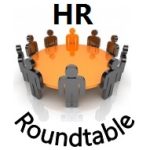As summer began, the (Cincinnati) HR Roundtable met to discuss a topic that is so often a formal program within organizations when it could be done more naturally.
What is that? Leadership development. We tend to make it a layered, cumbersome path fraught with favoritism and/or tradition. So, we thought we’d take a different look at this critical facet of organizations. To get started, the small groups jumped into these questions:
- What is a “leader”?
- Why do we only develop a few people in a narrow fashion?
- How can we make leadership development the norm in our companies?
The energy in the very full room jumped as people began to share their thoughts, opinions and experiences. When they reconvened, their answers were very solid!
1. What is a “leader”?
Something we tend to see very aspirationally — The majority of responses which started to pour out from the groups were positive adjectives and attributes. Items such as: someone with integrity, you can trust, inspires others and is willing to be vulnerable. These are all very strong aspirational descriptors. When Steve pressed the groups on this asking, “Is this what you see in leaders around you?” The answer was, “Well, we’d like to see these attributes.” Agreed. The challenge is for these to be behaviors, and not just a leadership wish list.
Someone who’s followed — This may seem like an obvious response, but it is the biggest sign that someone is leading. There are many self-proclaimed leaders in all organizations. The key is to see if others are following someone’s actions. If they aren’t, it doesn’t matter what a person calls themselves. Followership doesn’t automatically equate to a leader being effective mind you. There are many folks who are followed who don’t lead well. However, that’s a different topic for a future Roundtable.
Someone who is focused on others — When you combine this attribute with followership, you have a better likelihood that a leader is effective in what they do and say. Leadership is not about “them.” This self-awareness is a proven marker of leadership. One key thing to remember in this is that an others-focused person is also not reliant on a title or attaining a certain level in an organization. They do this all the time in every situation they work in.
Someone who provides direction and is consistent — These could also be seen as aspirations, but they are more behavioral in nature. You’d hope that leaders have a sense of assessing their situation and surroundings, and then have the ability to act with some form of direction. If this is exhibited consistently, as well as other behavior, people will acknowledge that this person is a leader.
Someone who is comfortable with change — We often talk about change in measures of extremes. We think change always occurs in massive shifts within organizations. This just isn’t the case. There are exceptions to this, but that’s what they are – exceptions. Leaders can sense, identify and roll with change. They don’t get flustered. They pivot, adapt and address change as it regularly occurs.
2. Why do we develop only a few people in a narrow fashion?
We plug holes in companies — In this current world of “talent,” our reality is that we plug openings when they occur. Too often we don’t look ahead at what our organizations should look like from a succession standpoint except for the very top levels. Therefore, we normally “develop” those who are tagged/destined to move up the corporate ladder. This has never been overwhelmingly successful or sustainable, but we keep following the same model.
Companies are stagnant in the midst of a fluid reality — We tend to think that things won’t change, and people won’t transition out of our company. We like to have things stable and comfortable with very little variability. This is ironic because people by their nature are fluid. It’s just so subtle that we don’t recognize it. People are constantly posturing, maneuvering and looking for ways to make their work experience better. So, when we tend to want to keep things the “same,” we miss that people are moving all around us.
We keep supporting the myth of “high potentials” — It is astonishing that companies have a small conclave of senior managers who sit in a room to rank, observe and designate staff at lower levels in the organization as “high potentials.” I picture these senior managers throwing their head back with pleasure after people have been named with a false sense of security. What’s intriguing about this method is that it doesn’t lead to development. It usually leads to an unrealistic leadership obstacle course to see if people can “rise to the occasion.” It’s archaic.
We don’t understand diversity and inclusion — In HR, and in organizations, we seek to be more homogeneous than we care to admit. The reaction to this is to make up a D&I program, committee or initiative. There is some merit to this because it puts a mirror up to organizations to make sure they aren’t being narrow. What we need to realize is that diversity and inclusion is a reality and not a program. Development needs to continue and exist for all employees instead of segments of folks. Development cannot be exclusive.
We don’t feel development is worth our time — It’s true. We are so focused on making sure people are at “work” that we feel crushed for time. How in the world can we develop people on top of all that we have to do? This is an upside-down view of how workplaces can be effective. We’ll cover this in the next section.
3. How can we make leadership development the norm in our companies?
Make the time for development — As noted above, we need to see that developing others is a great use of our time. The more we equip others to grow and perform, then work will be done more easily and effectively. It also broadens our perspectives personally and organizationally by including the thoughts, ideas and solutions given by those we develop.
Drop the report card mentality — HR, and organizations, are notorious for developing systems and programs that grade, rank and sort people. Then we make decisions on a person’s ability to contribute and grow based on this data. It lacks any form of contextual information. There are ways to create systems which include data as well as observational interpersonal behavior. We just need to be willing to dig in to do a more thorough look at our people!
Create a culture where people can lead at all organizational levels — Leaders don’t have to be at the VP or “C” level only. Remember this – a title doesn’t equate to leadership automatically. It’s just a title. That’s OK. You can have people who are extremely skilled from a technical standpoint who may/may not be great “leaders.” Organizations have room for that. They also have room for people to lead at whatever level of the company that people work – from the front line to mid-level supervision/management. From line functions to support functions. Leadership should occur throughout an organization and not just rest within a select few.
Develop relationships — HR should be out amongst the people. Period. No excuses. The more you are connected to your employees, the more context you personally observe on how people interact, treat others and lead. It also lets you be a check and balance to others in the company who may designate someone as a leader. You can see how they’re faring and help them out as needed.
Never cease development — Earlier it was noted that organizations are fluid. That’s the truth. Therefore, development needs to be fluid and on-going as well. We have to fight against the start/stop/start/stop jerky approach we’ve been using for decades. This is an exciting opportunity for HR to thrive. As long as your company has people, there are those who can develop and grow.
We had a grand time discussing leadership in a much broader terms than is usually done. We avoided all 3, 5, 7 and 10-step models of what leadership should look like, and people enjoyed tackling the topic.
